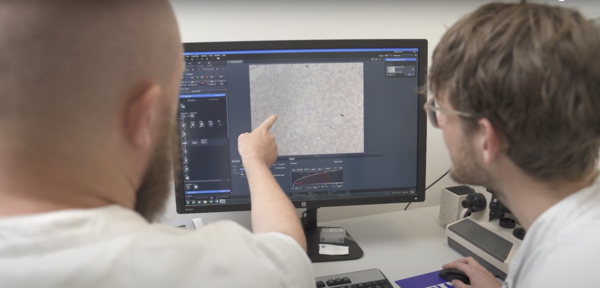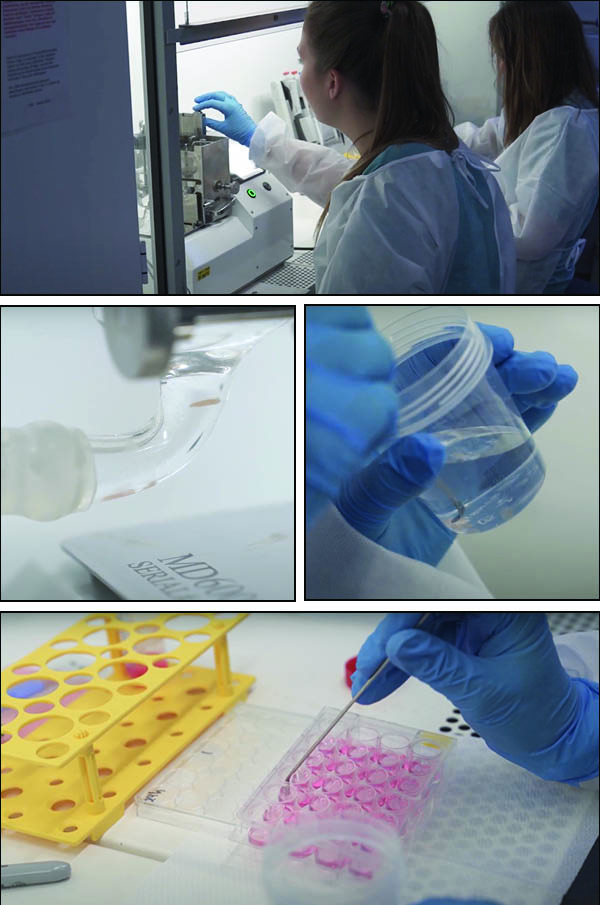Developing a human-based model for chronic kidney disease
A multidisciplinary team across three companies and Aarhus University set out to develop a model for chronic kidney disease based on fresh human kidney biopsies. Here you can read more about how the FRIGG team approached this task.
”Molecular insight into disease processes is key to develop prognostic tools and treatments. However, in many cases we are limited to cell culture models or animal models when we study disease mechanisms,” says Lene Niemann Nejsum. “For chronic kidney disease, this is a problem because our current cell and animal models do not quite recapitulate the complexity of human physiology or how the disease progresses in humans. That is why we are in desperate need for a human model system to help us in our search for new drugs and treatments,” elaborates Rikke Nørregaard.
Lene Niemann Nejsum and Rikke Nørregaard were leads on the FRIGG project and they had a common goal: They wanted to establish a human-based model for chronic kidney disease based on fresh human kidney tissue obtained directly from patients. Their aim for this human model was to mimic development and progression of some of the key processes in chronic kidney disease. This work was performed in the FRIGG project, which was a large interdisciplinary collaboration between several academic and industrial researchers.
Before we get into details about the different partners in the FRIGG project, let us first elaborate on the background for establishing the human-based model system for chronic kidney disease.

Chronic kidney disease - A widespread disease with no cure
Chronic kidney disease, also known as CKD, develops due to gradual loss of kidney function and the formation of scar tissue in the kidney. It is typically associated with various underlying medical conditions with lifestyle diseases such as diabetes, obesity and high blood pressure being the most prevalent causes. “If the injury persists, it will lead to fibrosis and further kidney damage, which will cause a decline in kidney function,” explains Rikke Nørregaard.
Ultimately, in end-stage CKD, patients will be placed on dialysis and may require a kidney transplantation to survive. A major problem is that many patients are diagnosed to late and therefore the kidneys have already been significantly and irreversible damaged. “Currently, there are no good biomarkers available for diagnosing CKD at early stages,” says Lene Niemann Nejsum and elaborates: “Even after diagnosis, there is little we can do for the patient and there is no effective cure for CKD. All we can do is to help the patient to gain better control of the underlying diseases to slow down the progression of CKD.”
Currently, it is estimated that more than 10% of the global population, thus more than 800 million individuals, are affected by different stages of CKD. Many of them are unaware that they are affected because the symptoms are non-specific and includes nausea, muscle cramps, swollen feet and ankles, and loss of appetite to mention a few.
There is, as mentioned above, no cure for CKD. The available clinical drugs are primarily aimed at slowing down CKD progression or reducing cardiovascular risks. However, the drug discovery pipeline faces challenges due to suboptimal model systems. Although several drugs targeting renal fibrosis have proved successful in animal models, almost none of these are used in the clinic. In fact, less than 10% of the drugs that enter clinical trials show clinical benefit.
This brings us back to the aim of the FRIGG project headed by Rikke Nørregaard and Lene Niemann Nejsum.
The need for a CKD model system using fresh human tissue
“We want to understand what initiates human CKD and also what drives the progression,” states Rikke Nørregaard. “If we can obtain an in-depth knowledge of these processes, it is much more likely that we can identify new biomarkers, which can be used to both diagnose the disease but also monitor the progression at the early stages,” she says. Currently there is no straight-forward method for neither diagnosis nor monitoring of disease progression. But a biomarker for early disease stages would for instance offer an opportunity to screen patients at risk for developing CKD, and thus allow clinicians to initiate treatment at earlier stages before the scarring is too comprehensive and irreversible.
In the future, the FRIGG model system can potentially also help overcome the problem of 90% of drugs failing clinical trials. “With a human-based model system for CKD at hand, researchers will have a better starting point for identifying potential drug targets. But more importantly, a human model system will also increase translatability between the laboratory and patients: If we can test drug candidates on fresh human tissue in the lab, there is a higher probability that we see the same effect in patients in the clinic,” says Lene Niemann Nejsum.
The set-up of a model system with fresh human tissues required many different competencies. And to set the right strategy, an interdisciplinary team with both cutting-edge academic knowledge and industry insights was necessary.

The FRIGG model system is developed by an interdisciplinary team of experts
The idea for the FRIGG model system was jointly developed in an open ideation process facilitated by the ODIN network, which funded the FRIGG project. “A major advantage of working in an open environment in ODIN, was the ideation process, where both academic researchers, medical doctors, and several industry partners contributed actively,” says Lene Niemann Nejsum. The joint ideation process across the industry-academia was implemented to ensure high industry relevance, which is a key requirement in projects funded by ODIN.
In addition to the academic researchers, the FRIGG project included three companies: AstraZeneca, Nordic Bioscience and Novo Nordisk. “The members of the FRIGG team all contributed with expert knowledge,” says Rikke Nørregaard and elaborates: “Combined we span expertise in renal disease, renal physiology, advanced bioimaging and methods for gene expression and biomarker identification. Each of us got to work on the areas that are most interesting and relevant to our key expertise – also the companies.”
The FRIGG model system can mimic CKD
The human-based model system for CKD is now well underway. The key “ingredient” was the fresh human tissue supplied by the surgeons in the FRIGG team. When hospitalized patients had their kidneys removed either due to cancer or CKD, fresh tissue was delivered directly from the operating theater to the research lab. Tissue from cancerous kidneys were always taken from the healthy part of the kidney.
In the laboratory, the tissue was cut into very thin slices that were then incubated in growth media and subsequently used for further analysis.
“All kidney slices were cultured for either 0, 24, or 48 hours. Slices from healthy kidney tissue were either left untreated (serving as controls) or were exposed to drugs that induced fibrosis or inflammation. To mimic advanced CKD scaring/fibrosis, we added TGF-b to the culture medium. For inflammation, we used TNF-a to mimic the early injury before the scarring begins,” says Rikke Nørregaard and points out that especially the induced fibrosis resembled the slides obtained from CKD kidneys. Thus, the FRIGG model system can mimic the early stages of CKD.
All kidney slices were analyzed by different methods. “For instance, the slices were subjected to standard histological methods to evaluate the morphology of the tissue. We also used spatial transcriptomics and advanced bioimaging to compare the expression of genes and proteins in the slices with and without treatment,” says Lene Niemann Nejsum and explains that the culture medium, in which the slices were stored, was also analyzed: “We looked for biomarkers in the culture medium used for the different slides. We saw a nice correlation between the increase in proteins in the medium and the expressed mRNA directly in the slices. This indicates that the slices can be used for biomarker discovery”.

The FRIGG project has led to new research projects
The FRIGG project has opened up new doors for future collaborations and research avenues. At the academic side, the FRIGG project has led to new project ideas and funding applications. In industry, valuable insights and outputs have also been gained from the project as explained by some of the industry partners.
“The FRIGG project focused on comparing preclinical and human kidney tissues using cutting edge technologies to identify translatable models. Therefore, the project has given us tools to enable greater understanding of chronic kidney disease pathomechanisms as well as helping improve how we assess new therapies,” says Shrikant R. Mulay from AstraZeneca.
His positive view on the FRIGG project is shared by Federica Genovese from Nordic Bioscience. “We now have a new assay in our toolbox that, in combination with the measurements of our biomarkers, we can propose to pharma customers to test their drugs. This fills a void in terms of human preclinical assays that pharma is definitely interested in pursuing,” she says and points out that the ODIN model is well suited for generating new knowledge that facilitates the development of products that can be commercialized downstream.
The FRIGG project has led to new research projects
The FRIGG project has opened up new doors for future collaborations and research avenues. At the academic side, the FRIGG project has led to new project ideas and funding applications. In industry, valuable insights and outputs have also been gained from the project as explained by some of the industry partners.
“The FRIGG project focused on comparing preclinical and human kidney tissues using cutting edge technologies to identify translatable models. Therefore, the project has given us tools to enable greater understanding of chronic kidney disease pathomechanisms as well as helping improve how we assess new therapies,” says Shrikant R. Mulay from AstraZeneca.
His positive view on the FRIGG project is shared by Federica Genovese from Nordic Bioscience. “We now have a new assay in our toolbox that, in combination with the measurements of our biomarkers, we can propose to pharma customers to test their drugs. This fills a void in terms of human preclinical assays that pharma is definitely interested in pursuing,” she says and points out that the ODIN model is well suited for generating new knowledge that facilitates the development of products that can be commercialized downstream.
